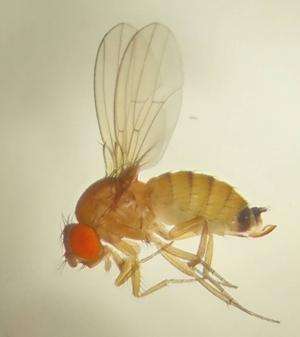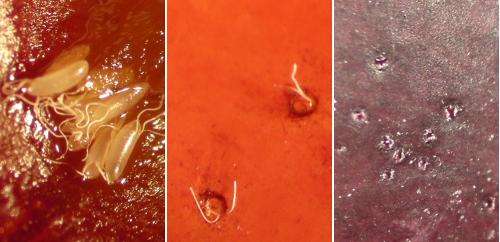'Breaking bad': Insect pests in the making

Of thousands of known species of Drosophila fruit flies, just one is known as a crop pest, depositing eggs inside ripening fruit so its maggots can feed and grow. New research from the University of California, Davis, shows the similarities and crucial differences between this pest and its close relatives—and that one related fly has potential to also become a pest.
Drosophila flies, found worldwide, lay their eggs in rotting fruit. Drosophila suzukii, also referred to as "spotted-wing Drosophila" because the male has large black blotches on his wings (as do males of several other closely related species), is able to penetrate the skins of ripening fruit and lay eggs inside.
"It was a surprise for western researchers when D. suzukii was identified as a pest," said Joel Atallah, a postdoctoral researcher at UC Davis who carried out the work with Artyom Kopp, professor of evolution and ecology, and undergraduate researchers Lisa Teixeira, Raul Salazar, George Zaragoza and Mubasher Ahmed. "Previously, it was thought that Drosophila would just lay eggs on rotting fruit."
D. suzukii apparently originated in Asia and was reported in Hawaii in the 1980s. However, it wasn't identified as a pest in North America until 2008, when a UC Cooperative Extension specialist sent samples of infested strawberries to Kopp's laboratory at UC Davis, asking for help in identification.

The same year, D. suzukii was found in Southern California orchards, and since then it has spread rapidly across the country.
Atallah and the undergraduate researchers analyzed the ovipositor, or egg-laying organ of D. suzukii and three other closely related species, D. subpulchrella, D. biarmipes and D. mimetica. They also offered lab-raised flies different fruits and observed whether they were able to lay eggs in them.
D. suzukii has a large, pointed ovipositor with prominent bristles. D. subpulchrella also has a large, bristly ovipositor, of slightly different shape, while the other flies have much smaller ovipositors similar to those of other Drosophila. They do have the same pattern of bristles, but they are much smaller and less visible.
In the lab, both D. suzukii and D. subpulchrella flies could penetrate the skins of cherries and raspberries and deposit eggs in them. D. suzukii flies, but not D. subpulchrella, made holes in grape skins, although they laid relatively few eggs there.
Kopp noted that even when the Drosophila flies could penetrate fruit, they were not very good at it, taking several minutes and multiple attempts.
Laying eggs inside ripening fruit is probably a recent development for Drosophila. Kopp speculated that as flies compete for good food sources in which to lay their eggs, there would be an advantage in being able to colonize fresher and firmer fruit. Eventually, this could have pushed D. suzukii to the point where it can penetrate fruit before it falls and starts to rot.
Controlling the flies will be challenging, Kopp said. Unlike the notorious Mediterranean fruit fly or Medfly, Drosophila flies are generalists with a wide range of food sources and breeding sites, and a generation time of less than two weeks.
"We want to identify which flies are dangerous and which are not," said Atallah. "D. subpulchrella has not yet been identified as a pest in the western world, but it may have the potential to become one."
More information: The work was published Feb. 26 in the journal Proceedings of the Royal Society B.
Journal information: Proceedings of the Royal Society B
Provided by UC Davis















